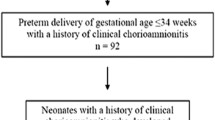Abstract
Purpose
We investigated prospectively cord blood TNF-α and IL-6 levels as diagnostic indicators of brain damage in neonates with non-asphyxia fetal distress.
Methods
Eighty neonates delivered by cesarean section from January 2013 to December 2014 were enrolled. Magnetic resonance imaging was conducted to determine brain damage. Neonates were assigned to a healthy control group (n = 30) or, with fetal distress, apportioned to groups with or without brain damage (n = 20 and 30, respectively). After delivery, the umbilical arterial blood of all neonates was harvested. Serum tumor necrosis factor-alpha (TNF-α) and interleukin 6 (IL-6) levels were evaluated to investigate a correlation between cord blood TNF-α and IL-6 levels and brain damage caused by non-asphyxia fetal distress.
Results
The TNF-α and IL-6 levels in the cord blood of brain-damaged neonates with fetal distress (75.63 ± 7.68 and 217.95 ± 25.15 pg/mL, respectively) were significantly higher than that of neonates with fetal distress without brain damage (43.67 ± 5.54, 119.08 ± 12.30 pg/mL) or the healthy neonates (42.35 ± 6.63, 128.46 ± 16.15 pg/mL); the latter two groups were comparable for both TNF-α and IL-6. The receiver operating characteristic curve showed that when TNF-α (IL-6) reached 53.23 pg/mL (156.23 pg/mL), the specificity and sensitivity for diagnosis of brain damage was 80.3% (82.5%) and 90.1% (81.5%), respectively.
Conclusion
Monitoring TNF-α and IL-6 levels in umbilical cord blood may assist early diagnosis of brain damage in neonates with non-asphyxia fetal distress.


Similar content being viewed by others
References
Parer JT, Livingston EG (1990) What is fetal distress? Am J Obstet Gynecol 162:1421–1425 (discussion 1425–1427)
Prior T, Kumar S (2015) Expert review—identification of intra-partum fetal compromise. Eur J Obstet Gynecol Reprod Biol 190:1–6. doi:10.1016/j.ejogrb.2015.04.002
Duggan PJ et al (2001) Intrauterine T-cell activation and increased proinflammatory cytokine concentrations in preterm infants with cerebral lesions. Lancet 358:1699–1700
Goepfert AR et al (2004) Umbilical cord plasma interleukin-6 concentrations in preterm infants and risk of neonatal morbidity. Am J Obstet Gynecol 191:1375–1381. doi:10.1016/j.ajog.2004.06.086
Gomez R et al (1998) The fetal inflammatory response syndrome. Am J Obstet Gynecol 179:194–202
Heep A et al (2003) Increased serum levels of interleukin 6 are associated with severe intraventricular haemorrhage in extremely premature infants. Arch Dis Child Fetal Neonatal Ed 88:F501–F504
Takahashi N et al (2010) Cytokine profiles of seventeen cytokines, growth factors and chemokines in cord blood and its relation to perinatal clinical findings. Cytokine 49:331–337. doi:10.1016/j.cyto.2009.11.024
Yoon BH et al (1996) Interleukin-6 concentrations in umbilical cord plasma are elevated in neonates with white matter lesions associated with periventricular leukomalacia. Am J Obstet Gynecol 174:1433–1440
Levy O (2007) Innate immunity of the newborn: basic mechanisms and clinical correlates. Nat Rev Immunol 7:379–390. doi:10.1038/nri2075
Vitoratos N et al (2006) Elevated circulating IL-1beta and TNF-alpha, and unaltered IL-6 in first-trimester pregnancies complicated by threatened abortion with an adverse outcome. Mediat Inflamm 2006:30485. doi:10.1155/MI/2006/30485
Kaukola T et al (2006) Population cohort associating chorioamnionitis, cord inflammatory cytokines and neurologic outcome in very preterm, extremely low birth weight infants. Pediatr Res 59:478–483. doi:10.1203/01.pdr.0000182596.66175.ee
Singh B, Merchant P, Walker CR, Kryworuchko M, Diaz-Mitoma F (1996) Interleukin-6 expression in cord blood of patients with clinical chorioamnionitis. Pediatr Res 39:976–979. doi:10.1203/00006450-199606000-00008
An H et al (2004) Interleukin-6, interleukin-8, and soluble tumor necrosis factor receptor-I in the cord blood as predictors of chronic lung disease in premature infants. Am J Obstet Gynecol 191:1649–1654. doi:10.1016/j.ajog.2004.04.014
Shahin M, Raslan H (2007) Comparative study of three amniotic fluid markers in premature rupture of membranes: prolactin, beta subunit of human chorionic gonadotropin, and alpha-fetoprotein. Gynecol Obstet Invest 63:195–199. doi:10.1159/000097844
Vitali U et al (1985) Perinatal fetal distress: correlations between Apgar score at birth and assay of CK-BB in umbilical cord blood. Quaderni Sclavo di diagnostica clinica e di laboratorio 21:249–252
Shen C, Yu Z, Liu Z (2015) The use of statistics in heart rhythm research: a review. Heart rhythm Off J Heart Rhythm Soc 12:1376–1386. doi:10.1016/j.hrthm.2015.03.016
Bryce J, Boschi-Pinto C, Shibuya K, Black, R. E. & Group, W. H. O. C. H. E. R (2005) WHO estimates of the causes of death in children. Lancet 365:1147–1152. doi:10.1016/S0140-6736(05)71877-8
Lawn JE, Manandhar A, Haws RA, Darmstadt GL (2007) Reducing one million child deaths from birth asphyxia–a survey of health systems gaps and priorities. Health Res Policy Syst/BioMed Cent 5:4. doi:10.1186/1478-4505-5-4
Azra Haider B, Bhutta ZA (2006) Birth asphyxia in developing countries: current status and public health implications. Curr Probl Pediatr Adolesc Health Care 36:178–188. doi:10.1016/j.cppeds.2005.11.002
Tonni G, Leoncini S, Signorini C, Ciccoli L, De Felice C (2014) Pathology of perinatal brain damage: background and oxidative stress markers. Arch Gynecol Obstet 290:13–20. doi:10.1007/s00404-014-3208-6
Li SJ et al (2014) The role of TNF-alpha, IL-6, IL-10, and GDNF in neuronal apoptosis in neonatal rat with hypoxic-ischemic encephalopathy. European review for medical and pharmacological sciences 18:905–909
Hata T et al (1996) Interleukin-6, interleukin-8, and granulocyte elastase in newborns with fetal distress. Gynecol Obstet Invest 42:174–177
Acknowledgements
This work was supported by grants from Yantian District of Shenzhen City Science and Technology Bureau (No. 2013004).
Author information
Authors and Affiliations
Corresponding author
Ethics declarations
Conflict of interest
All authors declare that there was no conflict of interest involved.
Research involving human participants
The Seventh People’s Hospital of Shenzhen Ethics Committee approved this study.
Informed consent
Parents or guardians provided informed consent.
Rights and permissions
About this article
Cite this article
Tian, C., Cheng, L. & Gu, X. Cord blood TNF-α and IL-6 levels as diagnostic indicators of brain damage in neonates with non-asphyxia fetal distress. Arch Gynecol Obstet 295, 337–342 (2017). https://doi.org/10.1007/s00404-016-4241-4
Received:
Accepted:
Published:
Issue Date:
DOI: https://doi.org/10.1007/s00404-016-4241-4




